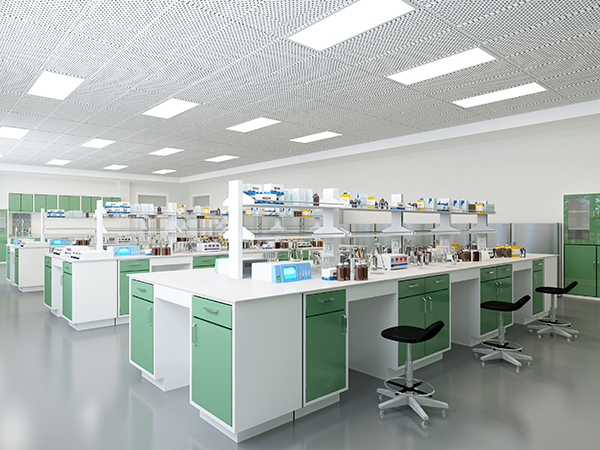Search
Search
Phone
Call
Mobile

Laboratory planning The design must consider the following:
Preliminary preparation for the laboratory:
Before performing laboratory planning and design, we must first understand the overall laboratory planning of the target laboratory, including the nature, purpose, tasks, basis and scale of the laboratory, and determine the laboratory functions and equipment selection. The instrument selection directly affects the layout of the laboratory.
First, the elements of laboratory planning
The contents involved in the planning and design of the laboratory mainly include the layout, water source, electric circuit, air circuit, and ventilation.
1. Floor plan;
Determine the overall floor plan of the laboratory and clarify the layout of the laboratory. The laboratory is required to be effectively isolated from the office area, the functional areas are clearly divided, the experiments do not interfere with each other, and the evacuation channels are unblocked.
2. Water source;
The water supply in the laboratory follows the principle of convenient access nearby, and sinks are set up where necessary. Especially some instruments that require an external water source must be equipped with a sink to facilitate water intake.
3. Circuit;
Circuit design must consider the overall power, three-phase power requirements, and the stability requirements of special instruments. In order to facilitate operation and meet the requirements of safety management, laboratories generally require independent control switches.
A correct and good grounding system is very necessary for the normal, reliable and safe operation of analytical laboratory instruments.
4. Gas path;
There are two modes of air supply: centralized air supply and separate air supply. The gas pipeline should be laid out along the wall to facilitate installation and maintenance.
5. Ventilation system;
Ventilation is an indispensable part of laboratory design. In order to reduce the injury of experimenters, the laboratory must be ventilated.
There are two ways to ventilate the laboratory, that is, local exhaust and full room ventilation. Local exhaust is to discharge nearby harmful substances after they are produced. This method can discharge a large amount of harmful substances with less air volume, and is widely used in modern laboratories. For some experiments, local exhaust air cannot be used, or when local exhaust air cannot meet the requirements, full room ventilation should be used. The focus of the ventilation system is the determination of the position of the air inlet and outlet and the pre-buried of the air outlet.

Two, equipment specifications and options
The content of laboratory equipment configuration mainly includes the layout mode, structural size, table top selection, fume hood selection, laboratory cabinet selection, and safety equipment configuration of the laboratory bench.
1. Layout mode;
The focus of the layout of the experimental platform is safety and convenience. There are several commonly used modes:
(1) Island type;
is the most common mode. It is often used in large spaces and rectangular indoor forms. This mode is characterized by smooth flow of people;
(2) Peninsula type;
This is also a typical application method, this mode is suitable for long and narrow rooms;
(3) L type;
L type is suitable for narrower rooms;
(4) U-shape;
The layout with a font (i.e. side experiment platform) is also commonly used.
2. Structure size;
The structure of laboratory equipment is divided into all-wood structure, steel-wood structure and all-steel structure. The laboratory can choose different types of test benches according to specific conditions. The size of laboratory equipment is directly related to the convenience and comfort of use. The height of the sitting workbench is usually between 750 and 850 mml. If the proportion of male experimenters is higher, 900mm height can be considered; the height of the standing workbench is between 850 and 920mm, and the height of the workbench in the high-temperature greenhouse is 450 ~600 mm; the length of the worktable should usually be considered to be 1200 mm per person (minimum should not be less than 1000mm), and the organic chemistry laboratory bench should be considered longer, which can be 1400 ~1600 mm; the height of the reagent rack is 1200 ~1650 mm The height of the cabinet can reach 1800-2000 mm; the depth of the working table is generally 750 mm, and the depth of the working table of the high-temperature greenhouse is generally required to be between 850 and 900 mm.
3. Laboratory table;
Currently, the most commonly used countertop materials are as follows:
(1) Epoxy resin: It is mainly reinforced epoxy resin with the same internal and external materials. It can be repaired and reduced when damaged. It is acid and alkali resistant, impact resistant, and high temperature resistant (about 800°C), and the cost is relatively high.
(2) Corrosion-resistant hardened board: It is made of high-quality multi-jammed paper, soaked in a special phenol liquid and then molded by high-pressure thermosetting effect, and has a special corrosion-resistant surface treatment. It has the characteristics of acid and alkali resistance, impact resistance, heat resistance, economical and durable.
(3) Trespa: 70% wood fiber and 30% melamine resin. Double electron beam scanning technology is used to attach melamine to the surface layer. After high temperature and high pressure molding, the resistance to high temperature and corrosion is average.
(4) Corrosion-resistant physical and chemical veneer: It is made of kraft paper impregnated with special phenolic resin, white and special surface paper processed by high temperature and high pressure. It is resistant to acid and alkali, impact resistance, and heat resistance, but it must be coordinated The base material is used.
4. Laboratory fume hood;
Fume hoods are the most commonly used local exhaust equipment in the laboratory. There are many types. Due to their different structures and different conditions of use, their exhaust effects are also different. The good performance of the fume hood mainly depends on the speed of air movement through the fume hood.
5. Experimental cabinet;
Experimental cabinets include medicine cabinets, medicine cabinets, dangerous goods, glassware drying and storage cabinets, clean cabinets, and biological safety cabinets.
(1) Sample cabinet;
The sample cabinet used to place all kinds of experimental samples should have partitions with compartments and labels that can be used to store samples and find samples, because some samples need to be dried according to the physical properties and chemical stability of the samples. The device is stored, so the compartments are large and small to facilitate storage of different samples.
(2) Medicine cabinet;
Mainly store solid chemical reagents and standard solutions. The two must be placed separately and cannot be mixed together. Chemical reagents should be placed in categories for easy searching. At the same time, for safety, the medicine cabinet should be equipped with glass doors and windows, and the cabinet should also have a certain load-bearing capacity and corrosion resistance.
(3) Dangerous goods storage cabinet;
Suitable for simple storage and short-term storage of dangerous goods, made of stainless steel or made of refractory bricks.
(4) Glassware drying and storage cabinet;
The cleaned off-duty utensils are stored on the bracket. The bracket is fixed to the cabinet with a guide rail, which makes the glassware easy to access and easy to clean and dry.
 Phone
Phone
 Call
Call
 Address
Address

About us
Company Corporate image Video Center HonorFurniture testing equipment
Mattress testing equipmentOffice chair testing equipment Furniture comprehensive testing equipment Sofa testing equipment Formaldehyde testing instrument ...More testing equipmentLab planning customer cases
Laboratory engineering Medical engineering New material engineering Third party inspection project Clean house project maintenanceLaboratory engineering scheme
Reliability test scheme Mechanical test scheme of finished productEnvironmental simulation test schemeEnvironmental safety test program...More laboratory engineering solutionsDynamic and contact
Company news Industry Information Q&A Talent Recruitment Online message Contact Huahong